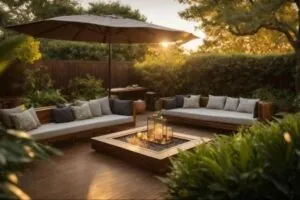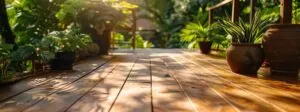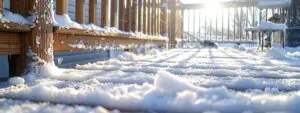Building a deck is an exciting way to expand your outdoor living space, but choosing the best wood for decks can feel like a daunting task. With so many options available, how do you decide on a material that balances style, durability, and affordability? Whether you are envisioning a sleek, modern look or a classic, rustic vibe, the type of wood you choose will play a significant role in shaping the deck’s appearance and performance over time. For more insights, you might find this guide on building a ground level wooden deck helpful.
The right wood ensures your deck can withstand the elements, provide a safe space for family gatherings, and add long-term value to your home. But it is not just about functionality—your deck should reflect your style and enhance the overall charm of your outdoor area.
This guide breaks down the most popular wood choices, highlighting their pros and cons to help you make an informed decision. You will find insights tailored to your needs and preferences from natural hardwoods to treated lumber. Ready to create a deck that is not only durable but also stunning? Let’s explore the best options to bring your vision to life with deck installation and design.
Why Choosing the Right Wood for Your Deck Matters
The type of wood you select for your deck sets the foundation for its durability, appearance, and overall value. A well-chosen material enhances the beauty of your outdoor space and ensures it can withstand weather elements like rain, sun, and snow for years to come. Picking the right wood means less maintenance, fewer repairs, and more time enjoying your deck.
Beyond durability, the aesthetic appeal of your deck heavily depends on the wood’s color, grain, and texture. Some woods naturally exude warmth and charm, while others offer a modern, polished look. Your choice reflects your personal style and contributes to the overall curb appeal of your home.
Additionally, selecting the best wood impacts your budget in both the short and long term. While some options may cost more upfront, their longevity and low upkeep often make them cost-effective. By choosing wisely, you can avoid frequent replacements or repairs, ensuring your investment pays off. Your deck is more than just a functional addition—it is an extension of your home, and the right wood makes all the difference.
Top Recommended Woods for Decks
Choosing the right wood for your deck involves balancing durability, cost, and aesthetics. While many options exist, some woods consistently stand out for their performance and appeal. Here is an overview of the most popular woods that combine functionality and beauty, ensuring your deck looks great and lasts for years.
Cedar: Lightweight and Naturally Resistant
Cedar is a top choice for decks thanks to its natural resistance to decay and insects. Lightweight yet durable, cedar weathers beautifully over time, developing a charming silvery-gray patina. It is easy to work with and offers a warm, rustic look. However, regular maintenance, like sealing and staining, helps maximize its lifespan.
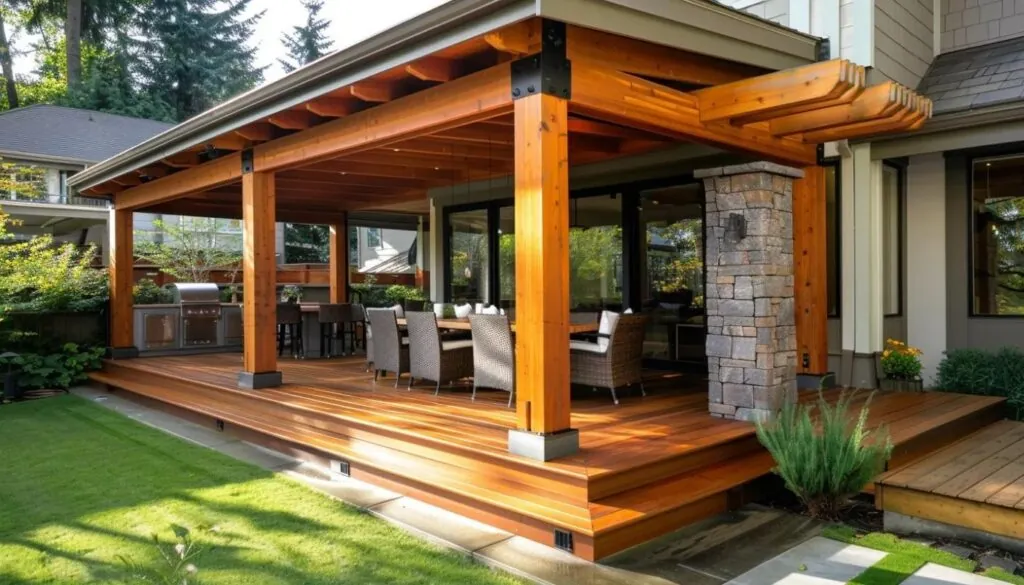
Redwood: A Balance of Beauty and Strength
Redwood combines natural beauty with impressive durability, making it a premium decking material. Its rich reddish hues and fine grain create an elegant look, while its resistance to decay and insects ensures long-term reliability. Redwood requires periodic sealing to maintain its color and structural integrity but is worth the effort for its timeless appeal.
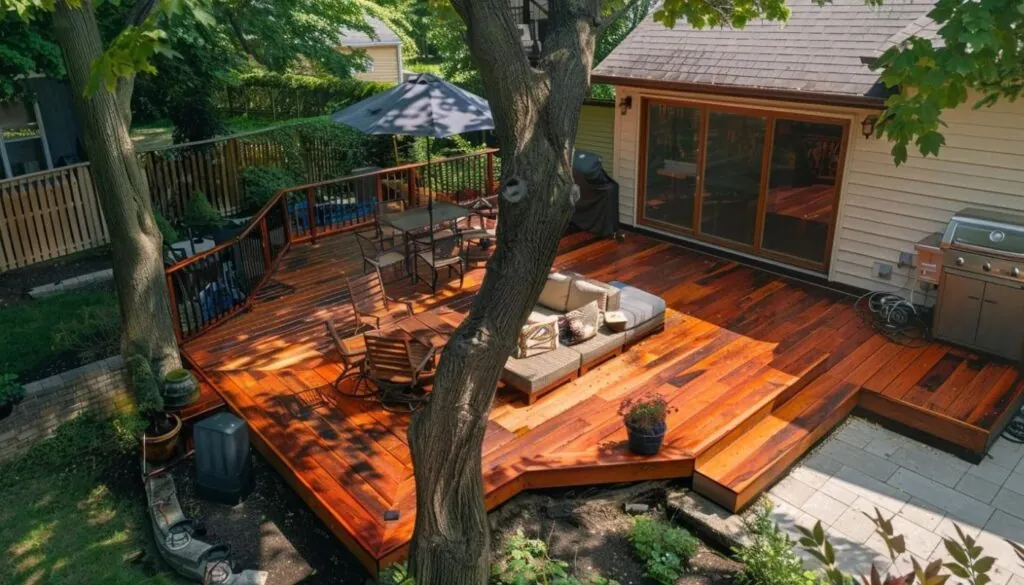
Pressure-Treated Pine: Affordable and Versatile
Pressure-treated pine is a budget-friendly option that is widely available and versatile. Chemically treated to resist rot and pests, it is ideal for those seeking durability without a high cost. Though it may require more maintenance to prevent warping and cracking, regular sealing can enhance its longevity and keep it looking fresh.

Ipe: The Premium Hardwood Choice
Ipe is renowned for its exceptional strength, density, and resistance to weathering. This tropical hardwood offers a rich, luxurious appearance with minimal maintenance and can last up to 50 years or more. Though pricier and heavier than other options, its longevity and unmatched durability make it an excellent investment for premium decks.
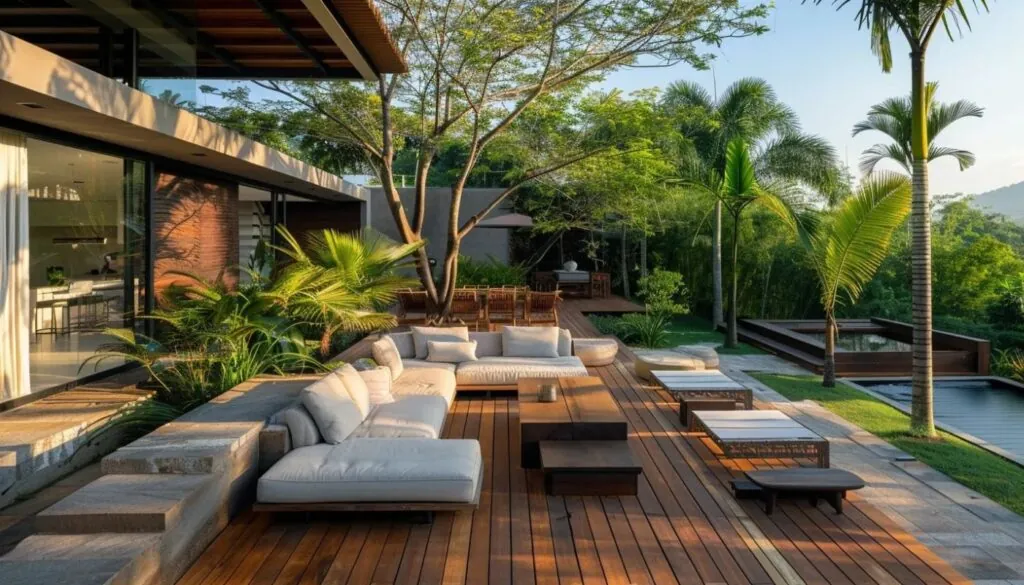
Factors to Consider When Selecting Deck Wood
Choosing the best wood for your deck involves more than just aesthetics. Understanding factors like maintenance needs and environmental impact ensures your deck looks fantastic and aligns with your lifestyle and values. Here are two crucial considerations to guide your decision.
Maintenance Requirements
Different woods require varying levels of maintenance to preserve their appearance and durability. Natural options like cedar and redwood need regular sealing and staining to protect against weathering. At the same time, tropical hardwoods like Ipe demand minimal upkeep but can be harder to work with initially.
Pressure-treated pine is cost-effective but prone to warping if not sealed periodically. Understanding the effort and cost of maintenance upfront helps you choose a material that suits your schedule and budget. If you prefer low-maintenance solutions, composite alternatives or naturally resilient hardwoods might be ideal.
Environmental Impact
The environmental footprint of your deck wood choice matters, especially with increasing awareness of sustainability. Locally sourced woods like cedar and redwood often have lower transportation impacts, while tropical hardwoods, though durable, can contribute to deforestation if not responsibly harvested.
Look for certifications like FSC (Forest Stewardship Council) to ensure the wood comes from sustainable sources. Alternatively, recycled or composite materials offer eco-friendly options without compromising durability. Balancing your deck’s environmental impact with your functional needs ensures a beautiful outdoor space you can feel good about.
Tips for Maintaining Your Wooden Deck
A well-maintained wooden deck extends its lifespan and enhances its appearance and safety. Proper care ensures your investment withstands weather, wear, and time. Here are essential tips to keep your deck looking its best and performing optimally. For more specialized advice and services, consider consulting expert deck repair and restoration services.
Cleaning and Sealing Practices
Regular cleaning removes dirt, debris, and mildew that can damage the wood. Use a soft brush and a mild cleaning solution to scrub the surface, rinsing thoroughly with water. Avoid pressure washing as it can harm the wood’s fibers.
After cleaning, apply a high-quality wood sealant or stain to protect against moisture and UV damage. Choose sealants that suit your deck’s wood type and reapply them every 1-3 years for maximum protection. Routine cleaning and sealing preserve and shield your deck’s natural beauty from the elements.
Preventing Rot and Warping
Preventing rot and warping starts with proper design and maintenance. Ensure your deck has adequate ventilation and drainage to avoid water accumulation. Inspect for signs of rot, like discoloration or soft spots, and replace damaged boards immediately. Warping can occur from prolonged exposure to moisture and heat, so store furniture carefully and avoid placing heavy objects on weak spots.
Apply waterproof treatments regularly to minimize moisture absorption. By proactively addressing these issues, you can extend the lifespan of your deck and enjoy its charm for years to come.
Conclusion: Choosing the Best Wood for Your Deck
Selecting the best wood for your deck is about balancing style, durability, and practicality. Each wood type offers unique benefits, from the natural charm of cedar and redwood to the strength and longevity of ipe and pressure-treated pine. By considering factors like maintenance needs, environmental impact, and your budget, you can make an informed choice that fits your lifestyle and enhances your outdoor space.
Your deck extends your home, a place to relax, entertain, and create memories. Choosing the right wood ensures it remains beautiful and functional for years. With proper care, like regular cleaning and sealing, your deck can withstand the elements and retain its charm. Whether you prioritize sustainability, low maintenance, or a stunning appearance, a perfect option is waiting for you. Expert deck designers and installers can help you make the right choice for your new deck!
Take the time to weigh your options and invest in a material that aligns with your vision. A thoughtfully built deck adds value to your home and provides a space for cherished moments outdoors.
Frequently Ask Questions About Wood Decks
What is the longest-lasting wood for a deck?
Ipe wood stands out as one of the most durable decking materials due to its high density and natural resistance to decay and insects. With proper maintenance, an Ipe deck can last up to 75 years.
What is the longest-lasting finish for a wood deck?
High-quality, oil-based penetrating stains are known for their longevity on wood decks. These finishes penetrate deeply into the wood, providing protection against moisture and UV rays, which helps prevent peeling and fading. Regular maintenance, including cleaning and reapplication every few years, is essential to preserve the deck’s appearance and durability.
What is the most durable wood decking material?
Ipe is considered one of the most durable wood options for decking, offering exceptional hardness and resistance to wear. Other durable hardwoods include teak and cumaru. However, these materials can be more expensive and may require more maintenance compared to alternatives like composite decking.
What is the most expensive wood for decking?
Exotic hardwoods such as Ipe, teak, and mahogany are among the most expensive decking materials due to their durability, aesthetic appeal, and limited availability. The high cost reflects their longevity and the premium look they provide.
Which timber is best for decking?
The optimal timber for decking depends on factors like budget, desired appearance, maintenance willingness, and environmental considerations. Pressure-treated pine is an affordable and widely used option, though it requires regular maintenance. Cedar and redwood offer natural resistance to decay and insects, with a more refined appearance. For superior durability and a luxurious look, hardwoods like Ipe are excellent choices, albeit at a higher cost. Composite decking materials are also worth considering for their low maintenance and long lifespan.
